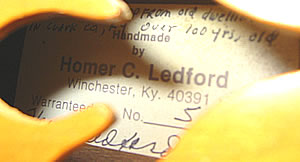The dulcimer is one of the few original American
musical instruments. It's ancestor, the scheithlot, was found in
the late 1700's in Pennsylvania. The Appalachian people changed
this instrument and came up with the dulcimer in the 1800's. The
word dulcimer means "sweet song", and that describes it well. The
Appalachian dulcimer is shaped like an hourglass, or like a woman,
as many say. In those days women playing a stringed instrument were
not allowed to stand in front of the men. So, they played the dulcimer,
which was played on the lap. Originally the dulcimer was strummed
with a quill. It can be played with a pick, bowed, fingerpicked,
or with a short piece of dowel called a "noter". Different
playing styles are used to bring out different sounds. Many chords
can also be played on this instrument. Dulcimers are handmade and
very beautiful. Most dulcimers have three to five strings, and while
tuning modes can vary, usually only the first string is used to
play melody, while the other strings provide drone accompaniment
and backing chords.
 Listen to a sample
of the dulcimer Listen to a sample
of the dulcimer
This dulcimer was custom made by the late Homer Ledford (1926-2006) of Kentucky, considered
to be a legend and master craftsman of the instrument. It
is made from Yellow Poplar wood that is over 100 years old, salvaged
from planks that were once slave cabins.
A traditional way to play the instrument is to lay it flat on the lap and pluck or strum the strings with one hand, while fretting with the other. In practice, a wide variety of playing styles are used. For solemn church and parlor music, a bow was traditionally favored, but in faster dance music, the dulcimer was plucked and strummed. When four strings are used, the first two strings are placed close together and tuned the same. This can be used to emphasize the melody, while the other two strings are used as drone strings. Some dulcimers are constructed to allow the strings to be arranged with either a "double melody string" (as described above) or with the option of four equidistant strings. The traditional way to play the dulcimer is to utilize the "one melody string and two drone strings" approach. Players who employ this method are known as "noters". More contemporary play has borrowed from chord theory and guitar analogues to create a variety of more complex ways to play the dulcimer. The Appalachian dulcimer is both easy to learn to play and yet capable of complexity, providing scope for a wide range of professionals and hobbyists.

Homer's signature and description, visible
through the maple leaf tonehole.
|
